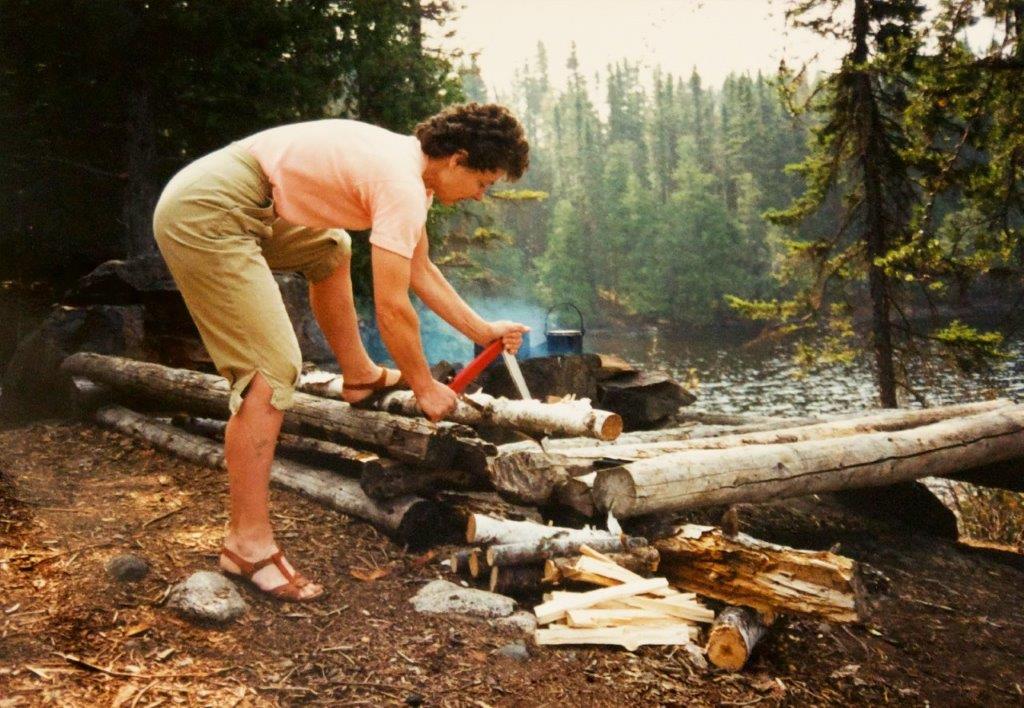When Dick Swenson logs on for the video call his daughter Linnea arranged for us, he grins widely, the smile extending up to the laugh lines etched around his eyes. He’s wearing a bright blue, fuzzy Nordic sweater (his wife knit it for him decades ago) that betrays how brutally cold it must be in Duluth, Minnesota, where he lives. It is January, after all. Swenson’s son-in-law Jon adjusts, the camera and subtly reminds the 92-year-old why we’re talking—then the interview is underway.
The talking doesn’t feel like work. Rather, my time with Swenson is one of those hours I know I’ll remember forever, even while I’m living it. True, I’m talking to the inventor of one of the most iconic backcountry tools, the folding, portable Sven-Saw that many of us have in our garages or garden sheds or tucked into our camping bins. What strikes me about Swenson, however, isn’t so much what he created as why he created it. His sincere desire to craft a tool that would make the world a little bit better comes through as he talks, as does the gratitude he feels for his collaborators.
Maybe it was that sincerity that, in 1962, led the manager of a small Seattle outdoor gear co-op to listen to Swenson’s pitch about his self-contained, foldable saw. It’s likely that Jim Whittaker, the first paid full-time REI employee and second CEO, was heartened by the two men’s shared vision to make it easier and safer for people to spend time outdoors—and so Swenson left the shop with a new customer. Today, the family-run Sven-Saw company creates one of just a handful of products that’s been sold continuously at REI for more than 60 years. “Sven-Saw is core to who we always wanted to be,” says REI historian Will Dunn of the community-centered nature of both businesses. Not to mention, “their product was brilliant. It was innovating on this idea of the saw to make it safer, lighter and more packable—and all of [those ideas] came from [the designers] just being outside.”

“There’s got to be a better way”
Swenson has always used his heart, head and hands in equal measure. As a child, he raised homing pigeons in the family’s barn-turned-garage, and one night offered them a cozy resting place in his brother’s car (he only did that once). At age 12, he thought it would be fun to ride a faster scooter, so he connected it to a lawn mower engine (alas, he was restricted to riding on back alleys until he got a driver’s license). As an adult, he became an engineer, spearheaded coal dust clean-ups in Duluth, Minnesota, and worked as the lead designer for a building automation brand, a paper plant and, later, a utilities company. “He was always doing things on the cutting edge,” says his daughter Linnea, “just seeing how things could be done a little more efficiently, a little better.”
That ability to see where improvements could be made—and then take action to make them—led to the Sven-Saw. In summer 1960, Swenson was out on a canoe trip with his brother in the Boundary Waters Canoe Area Wilderness, a massive area along the Minnesota-Ontario border filled with glacial lakes and untouched forests. On one of the many stretches of land between lakes that require canoers to carry their vessels, the brothers met two other men hiking out, one of whom had a heavily bandaged foot. When Swenson asked what had happened, the injured man explained that he’d accidentally cut himself with an axe blade because it didn’t have a cover to protect the teeth when it wasn’t in use. “I thought, ‘Oh my goodness,’” Swenson remembers, “There’s got to be a better way.’”
There was. And on Swenson’s next canoe trip a few weeks later, he brought along his first prototype.

Simple Ingenuity
The Sven-Saw is simple: blade, backbar, handle. There are just three facets to the tool, all held together in a sturdy triangle with a standard wingnut. The Swedish steel blade can rip through a 6-inch-diameter log in about a minute. The sheath houses the business end, rendering it benign during transit or storage. It nests into its own handle, with a small leather lace for hanging at home or the campsite. “All of it is intentional,” Linnea says of the Sven-Saw design, right down to the singular color available: red. “Last year, we spoke with a group of Girl Scouts, and one of them told me, ‘You don’t know how many times I have been the sweeper of the camp, and I have found the Sven-Saw because it had a red handle.’”
The 21-inch, folding Sven-Saw saw has long been a wilderness backpacker’s staple, thanks to its utility, compactness and weight (less than 14 ounces). It’s seen the limelight, too: The saw has been among some Alone and Survivor contestants’ limited gear packs. Individuals living solo in the woods (without a potential payout) have even shared their Sven-Saw stories with the Swensons, as have soldiers who brought their red-handled saw to Bosnia, Iraq and Afghanistan. One letter came from a couple of accidental survivalists who got stuck in a blizzard. Because they happened to have their Sven-Saw with them, they were able to cut up the only thing available for fire fuel: a fence.

The Sven-Saw isn’t only useful in life-or-death scenarios. Gardeners wield the blade against thick-stemmed intruders (Linnea has downed more invasive buckthorn than she can shake her saw at) and holiday revelers use it for cut-your-own Christmas trees. Kayakers and canoers rely on the tool to gnaw through “strainers,” the downed trees or debris that let water through but hold onto bigger objects, including boats. And scouts of all kinds bring their Sven-Saws along on group camping trips. “It is kind of fun to think that there is still a need for it,” Swenson says, an undercurrent of awe in his voice, “even though there are alternatives. I can honestly say that I think it is still the best camp saw.”
Not only that, but his design is made to last. “Treated with some respect,” Swenson says in a video interview from 2020, “[the Sven-Saw] will last longer than the person who owns it.” Fans can attest to that longevity. One 35-year-old Eagle Scout reports that he’s had the same saw (with a fresh blade) that he used since his Cub days. “Mine is 40+ years old,” says a customer from Raleigh, North Carolina. “Fifty years later,” boasts a proud Texan, “going strong.”
REI Co-op is a longtime admirer of the saw, which is why the Camp merchandise buyers order more of these member-loved tools time and time again. “It’s just a durable design,” co-op historian Dunn says. “It will get you through whatever it is that needs to be done. And then it’s something that can be passed down for generations. They really locked into something special with that.”
“I’ve used a sven saw for many many years and trips into Minnesota’s Boundary Waters Canoe Area Wilderness! It’s been passed down from my grandparents to me. They’re awesome at sawing downed logs for evening campfires on the lakes.”
Jay Halverson, senior sales specialist in hardgoods for REI Co-op in Bloomington, Minnesota
The Legacy Lives On
While creating a long-lasting, high-quality product was fundamental for Swenson, expanding the Sven-Saw product line was not. The company focused on its 21-inch saw for a decade before designing a 15-inch version for backpackers in the 1970s. In the same vein, Swenson never took on non-family employees because he didn’t want someone else’s livelihood to be tied to something he considered primarily a hobby that paid for itself. Plus, Swenson wanted to pursue other professional roles and ensure there was enough time for his top priority: his kids. “He had these big, important jobs,” Linnea says, but “we didn’t know it because he would come home and focus on us.”
As a result, Swenson turned to family members—his brother, sister-in-law, wife, and now daughter and son-in-law—to take the helm. “It’s been a wonderful experience,” Swenson says. “I am very fortunate to have the relationship that I have with all of the people who are participating in one way or another with the continuation of the company.”
Ahead of my talk with Swenson, Linnea had warned me her father’s memory is fading. “His thinking is much slower than it was at his prime,” she explained in our preliminary email correspondence.

It’s not apparent at first. Swenson easily recounts the story of how the Sven-Saw concept came to him on that canoe trip. He explains how he ended up in Washington in 1962 and met REI CEO Whittaker. He and his wife Cecile had ventured west to visit family in Tacoma, Washington, and decided to swing through Seattle to see the World’s Fair. While there, Swenson thumbed through the yellow pages and found a little outdoor shop called Recreational Equipment, Inc. Jim Whittaker alone stood behind the counter. The two chatted for a bit, and then Swenson remembers Whittaker saying, “Well, yes, why don’t you just send me one, and we’ll see how it goes.” “Then I got an order for probably three or four, and it gradually grew,” the inventor recalls.
Of course, the co-op’s reputation surged after Whittaker summited Everest in 1963, and so did Sven-Saw sales. Even now, more than 60 years later, REI accounts for a significant portion of the brand’s sales. “It became a wonderful, continuous [partnership],” Swenson says.
Here, time catches up with him. “As it turns out, I have trouble trying to remember their names,” he apologizes as he struggles to pull “Whittaker” and “Gary Rose,” one of the legendary REI buyers, from the depths. I’m struck by Swenson’s comment—after all, these were business associates from decades ago, so it makes sense to forget—but then he continues. “That’s a shame, because they were all good friends for a long time.”
As I digest those words, I hear Jon gently offer up Whittaker’s name for a second time in as many minutes. Just then, Linnea walks in the door after a separate meeting and gives her dad a hug. It all makes perfect sense. Those REI employees—like the family tenderly caring for him now, and the legions of Sven-Saw users who have sent Swenson love letters about his saw—are embedded in the fabric of Swenson’s life. They matter to him—deeply.
Our interview time is running out, so I ask one final question about how it feels to know he created something with such an impact, something built so well it has the potential to outlive its owner. “It’s just a wonderful ending thought, so to speak,” Swenson says, but then corrects himself. “Continuing thought, not ending.”
He’s right. The Sven-Saw story will continue, but more importantly, so will the quiet legacy of the man who created it, the man who believed in a better way—and then made it happen.

